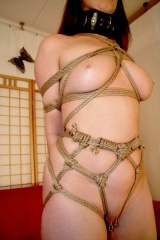 |
Peter Masters |
Peter Masters |
|
|
|||||
| About me | About this site | My books | |||||||
Rope bondage (decorative)
| Bondage articles | |
| Rope bondage | Predicament bondage |
| Rope bondage (functional) | Suspension bondage |
| Rope bondage (decorative) | Mummification |
| Rope harness | Breast bondage |
| Metal bondage | Hog-tie |

Japanese-inspired bondage

More Japanese-inspired bondage
Decorative rope bondage is performed to create attractive designs with rope, using the human body as the canvas. This artistic aspect is something that it can have in common with other BDSM activities such as cutting and piercing, and possibly branding and scarification.
Decorative bondage can be less "use-oriented" than functional rope bondage. That is to say that the purpose of functional bondage is often the restraint itself. With decorative bondage however, the appearance of the tie itself is the end result.
Decorative bondage creates a picture, often with the submissive or bottom as its centre. The positioning of their body, the colour(s) of the rope, the layout and style of the knots all play a part. Symmetry can also be important. The placement and tension of the rope can highlight or emphasise different parts of the submissive's or bottom's body.
Patterns---often the more intricate the better---are important in decorative bondage and a particular pattern may be repeated on different parts of the body.
Contents
Shibari
There are many styles of decorative bondage, but perhaps the best known is Shibari. This is based on a number of different Japanese rope patterns and tying styles. These can be quite complex, may involve interesting or awkward body positions, and almost always involve immobility.
Common factors
- Decorative bondage is often time-consuming. However, as the end result of the tie is the important part, more time is devoted to this than to what follows the tying.
- Decorative bondage creates an attractive, even artistic, package as opposed to a merely restrained bottom as in the case of functional rope bondage.
Books
- Screw the Roses, Send Me the Thorns: The Romance and Sexual Sorcery of Sadomasochism (Philip Miller and Molly Devon)
- Two Knotty Boys Showing You The Ropes: A Step-by-Step, Illustrated Guide for Tying Sensual and Decorative Rope Bondage (Two Knotty Boys)
- Shibari You Can Use: Japanese Rope Bondage and Erotic Macramé (Lee "Bridgett" Harrington)
- The Seductive Art of Japanese Bondage (Midori)